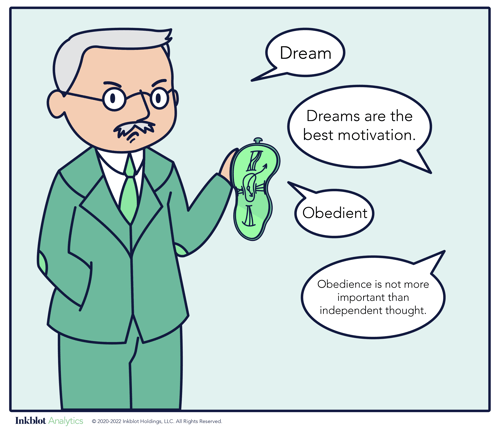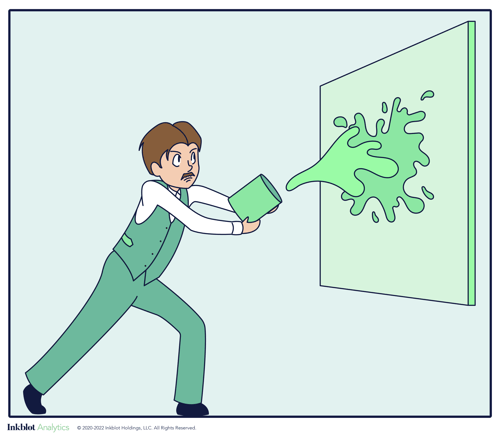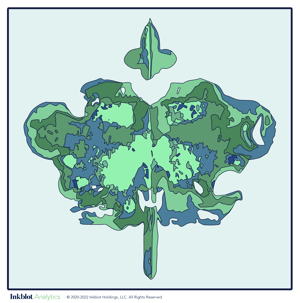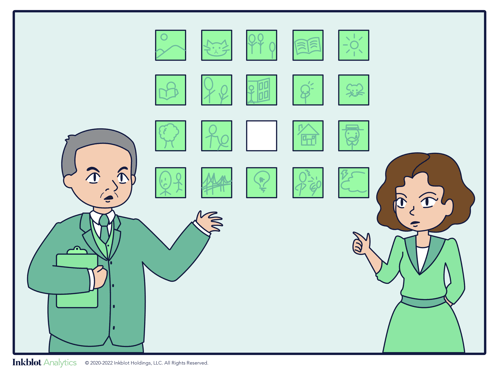Top Misconceptions of Projective Tests
No matter how much you’ve heard about projective tests, they are not what you think they are.
A hallmark of projective techniques is the relatively ambiguous stimulus used to elicit uninhibited psychological data.
Up to now, we’ve written blog posts on the theoretical and conceptual foundation of projective tests, but we have yet to discuss any particular projective test in depth. This week’s post will do just that.
A hallmark of projective techniques is the relatively ambiguous stimulus used to elicit uninhibited psychological data. Plenty of projective tests have emerged in psychological practices, but there are perhaps none more famous than: (1) the word association test, (2) the inkblot test, and (3) the thematic apperception test.
Starting in the year 1909—during a series of lectures given at Clark University—Carl Jung outlined his word association method.

The test itself is made up of a list of one hundred words ordered numerically. The words are specifically designed to target a person’s unconscious “complexes” (Jung, 1960, p. 18). Complexes are affect laden patterns of behaviors, thoughts, and memories that are:
formed from experiences that are causally related to each other and,
innate parts of personality determined by one’s temperament (Jung, 1960).
Jung demonstrated that the intensity of a complex, or its resulting “affective phenomena,” can be measured temporally, or as he wrote, “...watch in hand, we can easily determine the value of intensity from the time taken by the patient to speak about certain things” (Jung, 1960, p. 19).
The instructions and procedure are simple.
Directions: The participant is asked to “answer as quickly as possible the first word that occurs to your mind” (Jung, 1910, p. 220). The experimenter then records the reaction time—annotated in fifths of a second—and the associated response to each stimulus word.
Analysis: In Jung’s eyes, this back and forth between the experimenter and participant is a clever form of “conversation” that—through the presented stimulus words and participant’s responses—reveals the participant’s thoughts and feelings towards particular people, things, places, and experiences. The test categorizes certain types of individuals based on their responses
Objective types are undisturbed and do not reveal any connections to a hidden complex. For example, one objective type, when prompted with the word ‘green,’ responded with ‘blouse,’ or when prompted with the word ‘table,’ they responded with ‘chair’ (Jung, 1910, p. 220). Their behavior is aligned with the instructions of the experiment and does not deviate from the simple association task. These form the sets of normative responses.
Complex types showcase many disturbances in their responses. These responses are indicated by prolonged periods of delay (i.e., taking a long time to answer) or a direct repetition of the stimulus word. For example, Jung provided the case of a hysteric respondent who took almost ¾ of a second to reply to the stimulus word ‘money’ with ‘to buy/one is able’, (Jung, 1910, p. 227). Additionally, the subject repeated seven of the stimulus words verbatim. By taking longer times to respond, failing to respond with single word replies, and repeating the stimulus word, the person failed to follow the simple instructions and thus deviated in response. These are indicators of an underlying disturbance of the psyche. Instead of focusing on the task at hand, the person gets lost in the experiment, or as Jung summed it up, “the test person entirely forgets that we deal with mere words which stand print before us, and seeks in them a personal meaning; tries to divine them and defend himself against them, thus altogether forgetting the instruction” (Jung, 1910, p. 229).
Definition types respond in a manner that is redundant to or explanatory of the stimulus word. For example, responding to the term ‘apple’ with ‘tree,’ or ‘mother’ with ‘family.’ Jung indicated that the definition types tend to reveal the “intellectual significance of the stimulus word” (Jung, 910, p. 237). While some may appear to be unintelligent through redundancy, others may attempt to appear more intelligent than they are by giving elaborate responses. The other side of the definition type is the predicate type, where the subject expresses the emotional significance of the stimulus word. Jung provided the example replies: ‘piano—horrible’ and ‘to sing—heavenly’ (Jung, 1910, p. 237). Jung concluded that predicate type increases with age as we experience more significant emotional events.
Complex types can be differentiated from definite and predicate types because they try to conceal the complex, whereas the latter two work actively to exert influence over the experiment. Upon completion of the test, Jung would often conduct a reproduction, where the stimulus words are repeated to the subject under the task of recalling their former reactions. Jung wrote that when the “memory fails, and as experience shows, these locations are the stimulus words which touched an emotionally accentuated complex” (Jung, 1910, p. 238). Here, failure to reproduce a result from the prior test was also a sign of a complex because the person failed to remember the original association.
While Freud and Jung focused much of their writing on the pathology of “hysterics,” the word association test has been shown to reveal interesting information for non clinical populations.
For example, this effect can be found in an individual within the “intelligence-complex.” In this example, a person attempts to appear smarter than they actually are by reading into the nature of the test and assuming that it is measuring their intelligence. As such, they provide longer answers to appear intelligent to the observer. If someone feels inadequate in their everyday life, they might try to “overcompensate” on the word association test, providing multiple answers rather than just providing one as per the instructions. Here, an individual expresses the complex through the selection of “complicated foreign words, high sounding quotations, and other intellectual ornaments” that are unnatural to their education and intelligence level (Jung, 1910, p. 237).
Jung unearthed the apparent disconnect between language and memory recall that was indicative of a link to a previously emotional event.
Chances are you’ve heard of Hermann Rorschach’s inkblot test. It is one of the most controversial tests in psychology, and has been for well over 30 years. While the test initially garnered attention as a test for clinical diagnostic purposes, that was not Rorschach’s original intent. Goerg Roemer—a pen pal of Rorschach’s—wrote that Rorschach wished to “assemble some new material in the nature of inkblots to study some phenomena with which in earlier years he had been concerned, namely, reflex hallucinations. It was more or less by accident that he discovered that such inkblots could be used for diagnostic purposes” (Roemer, 1967, p. 185).
As the inkblot test was imported around the globe, its use cases expanded. Social and experimental psychologists started using it to understand personality, just as cultural anthropologists used it to understand different cultural meanings.
Regardless of how it was used, the ingenuity of the inkblot test is in its design.

The core of the test targets the function of two processes: perception and apperception. Perception is a process of organization, identification, and interpretation of sensory information. For example, a person might perceive the visually ambiguous input of an inkblot as the shape of a wing. Apperception is the assimilation of perceptions to past memories, experiences, or knowledge. For example, a person might perceive a wing in an inkblot (i.e., perception), make the connection that this wing belongs to a particular animal, like a bat, and express that the animal normally flies (i.e, apperception).
The inkblot test appeals to the “interpretation of accidental forms,” and was at one point labelled the “<<Form Interpretation Test>>” (Rorschach et al., 1942, p. 15, 181). To aid in interpretations of accidental forms, images were crafted by splashing inkblots onto a piece of paper, which was then folded in half to create horizontal symmetry. The inkblots, or plates, are colored black, black and red, or multicolored. Rorschach also noted that inkblots must fulfill certain requirements of composition, or subjects would commonly reject them without further interpretation beyond “simply an inkblot,” (Rorschach et al., 1942, p. 15). The true artistry behind each card is a wonderful mystery, as Rorschach himself did not provide a detailed set of techniques for reproducing the inkblots. Rather, he suggested that his—and only his—should be used in the perceptual, personalistic study of color, form, and movement. Why? Many researchers and scholars agree that Rorschach, who came from a lineage of artists and was a visual artist himself, embellished the inkblots with paint and a brush to achieve the extraordinary “spatial rhythms” that elicit kinesthetic engrams and trigger memories of familiar objects (Searls, 2017 p. 1, Meyer and Viglione, 2008). As neuroscientist GD Schott noted, methods used by artists to represent movement such as “wedges and inverted V-shapes” are seen in the Rorschach inkblots (Schott, 2014, p. 699).
These techniques are important, as they lend themselves to key aspects that psychologists code for when analyzing a person’s responses.
Traditionally ten official inkblots are used within a single test over the course of twenty to thirty minutes. The experimenter presents the blots, one by one, and asks the subject, “What might this be?” The inkblot is meant to be viewed at close range. Specifically—at no more than an arm’s distance—as to avoid alteration of the subject’s meanings (Rorschach et al., 1942, p. 16). Rorschach’s sample consisted of both normal, healthy people and his patients. This experimental control created a benchmark for the test results, and showed off the test’s utility with normal people and patients.

According to the authors, the “protocols of the experiment are examined according to the following scheme:
How many responses are there? What is the reaction time? How frequently is refusal to answer encountered for several plates?
Is the answer determined only by the form of the blot, or is there also appreciation of movement or color?
Is the figure conceived and interpreted as a whole or in parts? Which are the parts interpreted?
What does the subject see?” (Rorschach et al., 1942, p. 19).
Responses are totaled, subjective interpretations of form, movement, and color are inspected as parts or in whole, and finally the subject’s overall identification (i.e. what they saw) is addressed. Rorschach created a particularly artistic language of abbreviations for coding the subject’s responses.
Total responses (R) are simply the total number of responses to the inkblot in question. Normal responses include a range of fifteen to thirty. For example, manic subjects tend to provide above average responses, however the authors concede that the numbers alone are not sufficient to classify cases (Rorschach et al., 1942, p. 19). A failure to respond was notably uncommon in normal subjects, but pronounced in neurotics and schizophrenics (Rorschach et. al., 1942).
Form responses (F) are the most common type of interpretation, solely determined by the form of the blot. Form responses could also be classified as good or bad (F+/F-). Good form responses (F+) were a benchmark formulated through a range of recurring answers from normal subjects. For example, “Plate VIII interpreted as Two bears climbing from a rock, over an iceberg, onto a tree trunk,” is good form (Rorschach et. al., 1942, p. 38). On the other hand, a less clear response, like seeing Plate X as a”collection of butterflies,” would be an F- (Rorschach et, al., 1942, p. 55).
Movement responses (M) are determined when the subject interprets the stimulus in a kinesthetic manner (i.e. a feeling of motion). This is not a literal take on motion (e.g. a person walking). Rather the “sensation of motion” itself is influenced by kinesthetic engrams—memories of movement—such that the subject sees the inkblot in motion (Rorschach et al., 1942, p. 25). There are two types of M responses: primary and secondary. In the primary M, form and motion are assimilated rapidly and perceived simultaneously, while in the secondary M the form arrives first, then the motion.
Color responses (C) can be primarily determined by form or color, such that they produce a dominant response for one factor. An FC response is form dominant, yet still is significantly influenced by color. On the flipside, a CF response is color dominant, yet still is significantly influenced by form. There is also a primary color response; C. Rorschach concluded that “C answers have a “symptom value,” that is they represent the common trait of all these cases, namely, the tendency to improve emotional discharge,” (Rorschach et al., 1942, p. 32). In some cases, Rorschach reported what was called “color shock,” where colored plates became more difficult to interpret after viewing black and white plates.
Original responses (O) are those that occur infrequently, or as Rorschach wrote, “but once in a hundred tests” (Rorschach et al., 1942, p. 47).
The schema of interpretation is related to the apperceptive process. Rorschach noted that a normal subject might generally interpret the inkblot as a whole, then search for the prominent, distinctive features of the inkblot, and then finally the small details.
Whole (W) answers occur when the inkblot is interpreted as a singular object. There is a secondary type, (DW) where the “whole is arrived at from a detail” of the blot (Rorschach et al., 1942, p. 38).
Detail answers (D) come from the most distinctive features of the blot, while a small detail answer (Dd) comes from a larger amount of even smaller features.
Intermediate forms (S) are the perceptions of the white space, or background, instead of the inkblot itself. Rorschach noted that these types of responses are generally uncommon.
Finally, the content of a subject’s interpretation can be subdivided into six categories:
H content responses are the interpretation of an entire human figure.
Hd content responses are the interpretation of part of the human figure.
A content responses are the interpretation of an animal figure.
Ad content responses are the interpretation of part of an animal figure.
Obj. content responses are the interpretation of an inanimate object.
Ldscp. content responses are the interpretation of landscape.
So how does Rorschach’s aesthetic language play out in practice? It’s complicated, and requires expertise and training. The data, taken together with the entirety of the test results, enables the examiner to understand the individual’s psychology through their organized perceptions. Rorschach himself focused mainly on the patterns of perception, and placed a minimal, secondary focus on the content of his subject’s interpretations. However he was open to the idea of content analysis, which is where the test would evolve in the clinical domain (Roemer, 1967). The focus on how people saw (not what they saw), allowed him to draw conclusions about certain abilities, such as intelligence.
Rorschach saw the products of intelligence from his test as an indicator of an individual’s capacity to bring facets of intelligence to a given task, or as he stated, “the pattern of intelligence” (Rorschach et al., 1942, p. 66). Rorschach identified eleven facets of intelligence, which were computed from the protocols of the test, ranging from active attention (F+ and sequence), disposition to perform (W), clarity of perception (F+), optimum logical functioning, flow of associations (% A), and inner creation (M) (Rorschach et al., 1942).
Additionally, a focus on how people perceived the inkblots allowed Rorschach to draw conclusions about psychological profiles, or what he called “types.” For example, an experience type represents the relationship of the movement to color responses: introversive (movement dominant) and extratensive (color dominant). Conceptually, according to Rorschach, introversion is associated with “inner life” and often describes imaginative people, and extroversion is associated with “outward life,” and often describes more practical people (Rorschach et al., 1942, p. 79). To Rorschach these psychological types were not fixed features of personality, but universal and distinct psychological functions that developed. Since people were capable of both intro/extroversion, they represented flexible traits with habitual components. Therefore the experience type was related to “situations of affective dynamics, also with definite types of character” (Rorschach et al., 1942, p. 182).
Finally Rorschach lauded the test’s potential utility for healthy people in the differentiation of personality, and aid in the diagnosis of the quality of psychological illness for patients. He claimed that the test merely “lends itself to psychiatric diagnosis only in the hands of workers capable of collecting psychologically comparable material,” (Rorschach et al., 1942, p. 121). The test could, for example, aid in the differential diagnosis between neurosis and schizophrenia, which was a medical innovation at the time.
The Thematic Apperception Test, or TAT, was almost as popular as the Inkblot test. It was developed chiefly by Harvard psychologists Henry A. Murray and Christiana Morgan in the 1930s. It became popular as both a scientific tool for projective techniques as well as a tool for hiring practices and identifying distinctive cultural characteristics (Miller 2015).

In the year 1950, Murray read his suggested Uses of the Thematic Apperception Test at the 106th annual meeting of The American Psychiatric Association. Notably, the topic of the summit was projective techniques. Like all proper projective techniques, Murray touted the TAT’s potential for eliciting the covert aspects of personality, or as he phrased it, “subterranean mental processes” (Murray, 1950, p. 577).
In short, the TAT is a narrative based test where the subject creates either an oral or written story about the test stimulus. It is open-ended in the sense that there are no right or wrong answers. The test itself consisted of nineteen pictures and one blank card arranged in a pre-defined and consistent order. Murray made sure to reiterate the importance of this point—as many practitioners at the time did not abide by standardization—and as such the TAT was limited in cross case examinations. However, in the spirit of a growth mindset, Murray further suggested that the set be expanded to “20 or 30 pictures for general use” (Murray, 1950, p. 579).
According to Murray, best practices dictated that the test should be administered in a fashion that inspires creativity. The experimenter shows the subject a picture card and then allows them to examine it for ~twenty seconds before discarding. The subject is also told to pick a name for the main character prior to creating the story. This process typically produces stories of ~two hundred words in about five minutes. If the word count is low, without just cause such as certain clinical diagnoses, this indicates a defective “warming up process” between the patient and administrator (Murray, 1950, p. 578).
In terms of validity, the TAT assumes that the subject will incorporate parts of their own personality into the protagonist, their friends’ or family’s personalities into other relevant characters in the story, and their own memories in the plot. The contents of the story can be attributed to the overall life history of the patient, specifically the testing period, the current period (i.e. anything within the last month) or the past period (most importantly early childhood experiences).
Finally, Murray laid out five criteria for identifying key elements in a TAT story:
Symbolic significance is a theme that is related to one’s childhood.
Repetition is a theme that recurs more than three times.
Uniqueness are the elements that stand apart from the norm.
Interrelatedness is any segment that is relevant to an already existing significant theme in the story.
Subject’s self-involvement is the presence of the subject’s emotions, or defenses, in the story.
The interpretation of a TAT is no different than any other projective test in the sense that it must be viewed in a larger context. In fact, Murray suggests that the therapist only views the results of the stories, for the purpose of interpretation, after months of observation—to the point that the therapist “feels thoroughly at home in his patient’s stream of consciousness” (Murray, 1950, p. 580). At this point, the therapist might find a majority of what they know about the patient is disguised within the story.
The stories behind these famous projective tests are often forgotten. There are truly fascinating narratives behind the origins and developments of each test and their creators. Jung discovered that words have deeper meanings that matter, Rorschach opened his mind to observable patterns in our perception, and Murray found the construction of the self in the stories we tell.
It is only after careful study of these famous projective tests that the researchers at Inkblot Analytics were able to successfully craft their own projective tests, improved by recent developments in machine learning and AI. To see the link between older projective tests and the projective tests at Inkblot Analytics, just reach out to us here.
References
Jung, C. G. (1960). Collected works of c. g. jung, volume 8 : Structure and dynamics of the psyche. ProQuest Ebook Central, 18-19.
Jung, C. (1910). The Association Method. The American Journal of Psychology, 21(2), 219-269.
Miller, J. (2015). Dredging and Projecting the Depths of Personality: The Thematic Apperception Test and the Narratives of the Unconscious. Science in Context, 28(1), 9-30.
Murray, H. A. (1951). Uses of the Thematic Apperception Test. The American Journal of Psychiatry, 107, 577–581.
Petchkovsky, L., Petchkovsky, M., Morris, P., Dickson, P., Montgomery, D., Dwyer, J. and Burnett, P. (2013). fMRI responses to Jung's Word Association Test: implications for theory, treatment and research. J Anal Psychol., 58: 409-431.
Roemer, G. A. (1967), [1921]. The Rorschach and Roemer Symbol Test series. Journal of Nervous and Mental Disease, 144(3), 185–197.
Rorschach, H., Lemkau, P., Kronenberg, B. (1942). Psychodiagnostics : a diagnostic test based on perception, including Rorschach's paper. The application of the form interpretation test (published posthumously by Dr. Emil Oberholzer). Berne, Switzerland: H. Huber; New York: Grune & Stratton.
No matter how much you’ve heard about projective tests, they are not what you think they are.
By tracing the history of the term projection you will better understand how we generate consumer insights backed by behavioral science.
Discover how psychologists used general principles and conceptual similarities of projection to establish the sub-discipline of projective...
Be the first to know about new psychological insights that can help you optimize customer touchpoints and drive business growth.